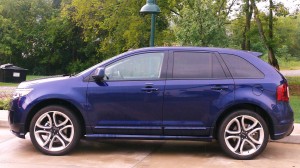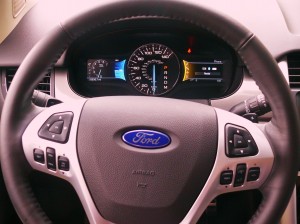Ultra-connectivity gives 2011 Edge to Ford
Anyone who has ridden in a new vehicle in recent years can appreciate all the creative technology in navigation systems, and the ability to link to cell phones, and miniaturized musical devices. But with the new 2011 Ford Edge the emphasis goes beyond the numerous styling and driveability changes. Think of the 2011 Ford Edge as the most futuristic multiple-connectivity device on the planet, and it just happens to come packaged inside a new and progressive crossover SUV.
The Ford Edge has sold well in its first generation as a stylish crossover, and it would be easy to characterize the 2011 Edge by its impressive restyling inside and out. Easy, but far from adequate. The new Edge has edgier styling, so to speak, and a revised interior, with upgraded power and great attention to vault-like silence for its occupants. But the Edge is also the new vanguard for Ford’s determined effort to make its cars the highest of high-tech connectivity for a new generation of buyers.
The “old” generation of buyers might simply want a vehicle that will provide solid and efficient transportation, and they might have scoffed when Ford hooked up with Microsoft to create some useful and flashy ways for its “SYNC” system to work with the latest electronic gizmos. But it’s time for the old generation to realize the new generation is fast becoming the standard for generations to come. And the new Edge is the perfect example of what we can see in increasing doses of new vehicles.
Every manufacturer wants to attract the new and younger customers, and all have made moves to add various jacks and input features to allow people to hook up their cell phones or iPod of MP3 music devices. SYNC put Ford into the forefront, but it couldn’t have foreseen the breakthrough technology that can be obtained in the new Edge.
The introduction of the new Edge was interesting. Frank Davis was host of the presentation and talked about how Ford will have the most new introductions in 2011 that he has ever witnessed. “The Edge has bold styling, powerful and efficient engines, improved driving dynamics, and revolutionary technology,” Davis said. “Along with class-leading power and fuel economy, and ride, handling and steering improvements, there are 17 new features on the new Edge, and 11 of them are class exclusive.”
The interior features a flat panel for a center stack, copied from the great design of Volvo, which Ford owned until a year ago. It also offers Ford’s high-tech 3.5-liter V6, and an upgraded 305-horsepower 3.7, featured in a new Sport model with paddle shifters on the 6-speed automatic, and such important improvements as trailer sway control. Those features will be bolstered when Ford also introduces its EcoBoost turbocharged 4-cylinder with 285 horsepower and fuel economy beyond the estimated 25 mpg of the V6.
One of the features Ford is pushing is partnership technology. Just as it did with Microsoft on SYNC, Ford now is partnering with Sony to advance its instrumentation, audio and connectivity, and it is linking up with Sirius satellite radio to create an instant replay of broadasts for later playback, plus high-definition radio that can be downloaded back to a portable audio MP3 system. A final partner is TeleNav, which upgrades the navigation system for improved turn-by-turn, point-of-interest, economic routing, and altering the nav screen to a 3-dimension-like view that shows landmarks.
Davis turned the presentation over to Elaine Bannon, the chief engineer of Ford’s crossovers, and she desrcribed the Edge Sport’s 22-inch forged aluminum wheels and stand-alone styling accents, and pointed out such important things as having the best second-row legroom, reclining rear seats, and a fold-down capability for hauling things up to 8 feet in length.
Those are all important assets for the new Edge, but the star of the whole show was — by far — still to come with the MyFordTouch, audio and nav coordination. John Schneider, chief engineer of multimedia — a title that didn’t exist a couple of years ago — showed off the Sony-design instrument panel. Honda has worked with Sony in recent designs too, and if Davis was startled that I suggested the new Edge intrument cluster is remindful of Honda’s, he shouldn’t have, because I meant it as high praise. Honda ergonomics are world-class, and this brings Ford right up there too.
Ford’s intention is not to simply load up its vehicles with gadgets; these futuristic gadgets are designed to allow drivers to keep their hands on the steering wheel and their eye — and presumably their attention — on the road and the driving responsibility at hand. As Schneider explained, the new generation wants to be continuously connected, so Ford is striving to find safe ways to connect and operate all devices, with touch and voice controls.
There is a large central knob on the center stack that can change modes of what you want to control. There are two USB jacks, a slot for an SD card, and RCA jacks. With many high-tech cars, a driver might actdivate 100 first-level commands; with the MyTouch in the new Ford Edge, that number goes to over 10,000.
Among examples of what the Edge can do:
- The driver says, “Call home,” and the system makes the phone call via Bluetooth, allowing talking and listening without moving either hand off the wheel.
- The driver says, navigation, then asks for an address, like “123 Central Avenue,” and the nav system immediately guides you, by the dash screen and by voice commands, to that address.
- The driver says, “Increase fan speed,” or, “increase temperature to 70,” and the system alters the climate control.
- Having already programmed your favorite songs into the system, or having plugged your iPod or other device into the SYNC system, the driver says, “Play song ‘Beg, Steal or Borrow,’ ” and the system goes to that newly released song by Ray LaMontagne, which you installed the day before. It’ll do the same with an old Everly Brothers or Waylon Jennings song, by voice command. If the song hasn’t been downloaded, it will treat your hooked-up iPod as though it was part of the system.
- A phone call comes in, and you can answer it, again by voice command, while keeping your hands on the wheel and your eyes on the road. If you get a text message to your cell phone, the system will read it aloud. Don’t ask me how! Beyond that, if the time comes when you want to disconnect your connectivity, you can click onto a “Do not disturb” mode, which then will transfer all calls to your call-waiting, or transfer text messages to your cell phone.
The SYNC services now include traffic, turn-by-turn, MapQuet, Google, sports scores, weather, news, movie listings, and stock quotes, which you can order “Send to SYNC.” If you’re listening to Sirius satellite radio, and a neat new song comes on, you can record it by a “tag” feature that records the song to your music device, or for up to 34 minutes of recorded broadcasting for later playback.
The Sony audio system is a 390-watt unit with 12 speakers surrounding you in the Edge, and it has a Class D fully digital amplifier, with digital processing, Dolby, and HD radio.
But here’s my favorite feature. If you get the proper plug-in data modem, you can plug it into the Edge and the vehicle becomes your own, private Wi-Fi hot spot, and up to five different computers or devices can hook up to it.
When we took the Edge out for a drive on its introduction tour, the intricate route that usually requires a guide-book had all been programmed into the slick new nav system. If we pulled into a rest stop or some other shop, the SYNC voice would ask if we wanted to reprogram the route. If we said yes, it would completely redo the guidance based on where we were heading, off the previous route, so we had to say “No,” in which case once we got back on the route the system picked up its pre-programmed route.
I had the pleasure of having Frank Davis ride with me, and we had some great conversations. He seemed to enjoy my heckles, and I appreciated his candid responses. For example, the audio system has a large knob prominently located. You push it to turn it on, and you turn the knob to get more volume. “What a concept!” I said. He laughed at the irony that even with the most imaginative electronic devices ever put into a vehicle, you could still go back to the good ol’ days of manually turning a knob to increase the volume.
The Edge drove well, handled superbly, and, with the thicker acoustic glass and all sorts of sound-insulation, was amazingly quiet. My only complaint was that the rubbery feel of the turn signal stalk always returned to its neutral setting, even when you put the turn signal on. Repeatedly, I found myself noticing its angle and assumed it hadn’t engaged, so I’d switch it again — which turned the signal off. That meant I made a dozen turns with my turn signal briefly turned on, and then emphatically turned off. Not good.
Davis suggested you could hear the turn signal clicking to indicate it’s on. But not, I told him, if you happened to be enjoying the fantastic Sony audio system. Maybe you could get used to the feel, but it is a cause of concern.
That, however, should be an elementary fix on the most futuristic vehicle on the planet.





 John Gilbert is a lifetime Minnesotan and career journalist, specializing in cars and sports during and since spending 30 years at the Minneapolis Tribune, now the Star Tribune. More recently, he has continued translating the high-tech world of autos and sharing his passionate insights as a freelance writer/photographer/broadcaster. A member of the prestigious North American Car and Truck of the Year jury since 1993. John can be heard Monday-Friday from 9-11am on 610 KDAL(www.kdal610.com) on the "John Gilbert Show," and writes a column in the Duluth Reader.
John Gilbert is a lifetime Minnesotan and career journalist, specializing in cars and sports during and since spending 30 years at the Minneapolis Tribune, now the Star Tribune. More recently, he has continued translating the high-tech world of autos and sharing his passionate insights as a freelance writer/photographer/broadcaster. A member of the prestigious North American Car and Truck of the Year jury since 1993. John can be heard Monday-Friday from 9-11am on 610 KDAL(www.kdal610.com) on the "John Gilbert Show," and writes a column in the Duluth Reader.